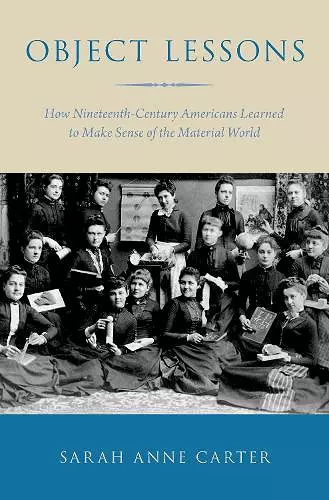Object Lessons
How Nineteenth-Century Americans Learned to Make Sense of the Material World
Format:Hardback
Publisher:Oxford University Press Inc
Published:6th Sep '18
Currently unavailable, and unfortunately no date known when it will be back

Object Lessons: How Nineteenth-Century Americans Learned to Make Sense of the Material World examines the ways material things--objects and pictures--were used to reason about issues of morality, race, citizenship, and capitalism, as well as reality and representation, in the nineteenth-century United States. For modern scholars, an "object lesson" is simply a timeworn metaphor used to describe any sort of reasoning from concrete to abstract. But in the 1860s, object lessons were classroom exercises popular across the country. Object lessons helped children to learn about the world through their senses--touching and seeing rather than memorizing and repeating--leading to new modes of classifying and comprehending material evidence drawn from the close study of objects, pictures, and even people. In this book, Sarah Carter argues that object lessons taught Americans how to find and comprehend the information in things--from a type-metal fragment to a whalebone sample. Featuring over fifty images and a full-color insert, this book offers the object lesson as a new tool for contemporary scholars to interpret the meanings of nineteenth-century material, cultural, and intellectual life.
Blending intellectual and cultural history with material and visual analysis, Sarah Anne Carter's Object Lessons: How Nineteenth-Century Americans Learned to Make Sense of the Material World reveals new perspectives on how American educators used material knowledge to provide children with the language and thinking skills needed to navigate the social turmoil of industrialization, urbanization and race relations. * P.J. Carlino, Parsons School of Design, Journal of Design History *
Moving between Europe and North America, [Carter's] work concretizes abstract notions about the international circulation of ideas and practices. As is proper for a book about object lessons, its heart lies in the material: the volume boasts more than fifty illustrations, almost half of them gorgeous colored plates... It is an homage to the book's argument and subject matter to say that this is a book worth acquiring even if just for the illustrations. * Karen Sánchez Eppler, Amherst College, Winterthur Portfolio *
This is a short, persuasive book important for education historians and all historians interested in the turn to material culture of the early twentieth century. * Sally Gregory Kohlstedt, University of Minnesota, American Historical Review *
Carter's work is most nuanced when it addresses the complications of race, class, and gender in the conceptualizations and goals of the "object lessons" and how their practitioners perceived their efforts. When she teases out the intentionality underlying the pedagogy of teaching with and through objects, Carter shows how people can learn from objects and how this pedagogy was used in past centuries to excite learning, generate deep thinking, and at the same time train the bodies and minds of those who learned through its sensory approach. * Diana B. Turk, New York University, Journal of American History *
This short read is the result of ten years of work at noted institutions consulting with skilled professionals. It contains 143 pages of text with the remaining 56 pages made up of an index, some rich footnotes, and a large selected bibliography. The book is well researched and documented * Debbie SchaeferJacobs, History of Education Quarterly *
Carter's book is accessible, evovative, and engaging...[it] contributes to the fields of American studies, American history, and the history and foundations of American education. * John H. Bickford III, The History Teacher *
ISBN: 9780190225032
Dimensions: 155mm x 236mm x 23mm
Weight: 517g
218 pages